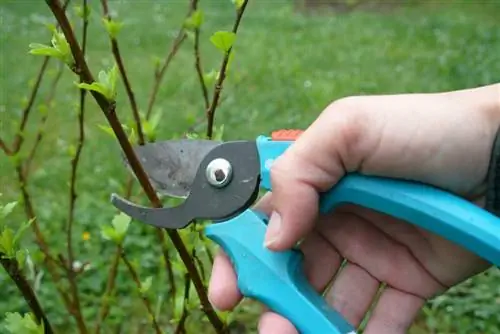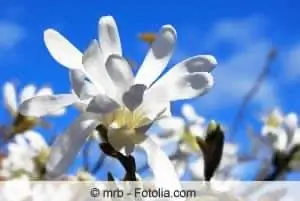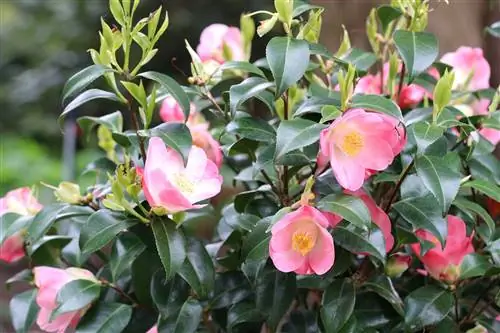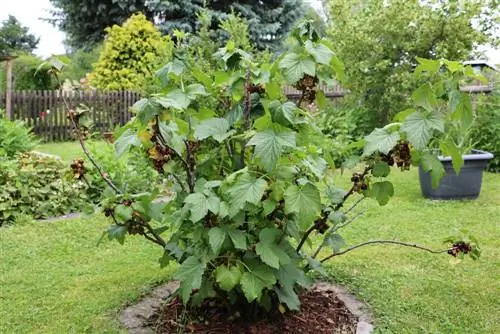- Author admin [email protected].
- Public 2023-12-17 03:39.
- Last modified 2025-06-01 06:48.
While some plants get along without any problems, others lose their flowering power without it and even produce fewer and fewer leaves over time. Cutting bushes and shrubs cannot always be avoided, even if there is enough space. With this measure, however, it is important to take into account the right time, the correct procedure and the individual requirements of the plant. Otherwise, at best only the flowers will fail in one year, at worst bushes and shrubs can be completely destroyed.
Individual circumstances
Magnolia or lilac, gooseberry or hazel - shrubs and bushes have one thing in common: they all have individual requirements and special features. This also applies to offcuts. Although there are tendencies regarding both the best time and the form of cutting, there are also numerous exceptions. Before the first cut, it should be clear which type of plant it is. And what special features it has. Hobby gardeners can't avoid a little research here.
Tip:
Make a sketch of the site plan and plants and note the respective requirements and cutting times as well as fertilization dates. This individual help eliminates any later confusion or the need to look things up again and again.
Cutting tools
Despite all the differences in waste, there is one thing that this measure has in common: the preparation of the cutting tool. Many people underestimate the role played by the knives, scissors and saws they use. These come into direct contact with the fresh cut surfaces, i.e. the open injuries to the plants. The blades and cutting edges should therefore receive special attention. Please note the following:
- Clean cutting tools thoroughly after or before each use and plant change, preferably disinfect them
- only use sharp or sharpened blades
- Prefer mechanical tools, only use electrical or petrol-powered devices on robust plants
Only use the knife to clean up the cut surfaces
The purpose of these points is to put as little strain on the bushes and shrubs as possible. Clean, germ-free blades cannot introduce pathogens into the cutting surface and reduce the risk of infections. Sharpened blades do not crush or shred the plant parts, allowing the open cut surfaces to close faster and better. This in turn prevents infestation with pests and diseases. And also ensures less surface area for burns.
The preferred choice of mechanical scissors and knives meant smoother cutting surfaces. Motor-driven variants often shred at least the leaves, but usually also wood and bark. This means that shrubs and bushes can be trimmed more quickly overall, but they then become susceptible to parasites and germs after each intervention. In addition, the optics can be disturbed. Subsequent processing of the cut surfaces is often advisable for hard wood, thicker shoots and branches if a saw had to be used. But even if the cutting resulted in cracks and pieces of bark being torn off, the surface can be smoothed out with a knife and cleaned up. The smoother surface seals more quickly than is possible with uneven surfaces. The risk of infections and invading pests is reduced.
Time
Whether spring or autumn, a few rules should be followed when choosing the time. Lighting conditions and weather play a particularly important role in waste. The following points are crucial:
- do not cut in high heat or in the blazing sun
- Avoid frost on the day of cutting
- If possible, do not cut in rain or high humidity
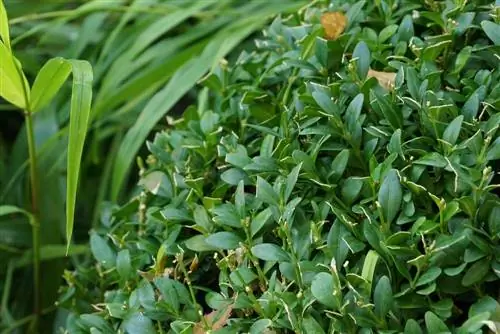
Moderate temperatures are usually ideal, between 15 °C and 25 °C. Dry air can help the washing to close the cut surfaces as quickly as possible. Dry heat and direct sunlight, on the other hand, lead to burns. However, very humid air or even rain prevents drying. Damage also occurs when there is frost. So good timing is required here.
Cutting shapes
When cutting shrubs and bushes, a fundamental distinction is made between different shapes. These include:
- care cut
- Blending
- Rejuvenation cut
- Forming
- Compression
When pruning, only damaged plant parts and dried flowers are removed; all he althy and living shoots are retained. These are simply corrections. Depending on the plant, however, weak, thin branches can also be removed or the size reduced.
The aim of thinning is what the name already suggests. Shoots that grow inwards, cross each other or restrict each other are removed. This measure is recommended now and then, especially with berries, as it provides the fruit with sufficient light.
The rejuvenation cut is much more radical. For many plants, the branches are cut back close to the ground or at least shortened significantly and back to the main shoots. The idea is to remove over-aged plant sections and thus stimulate new growth. The shaping, for example of a box tree or a hedge, is often quite radical at the beginning, but is carried out in several steps. The goal is to achieve a special, artificial shape. The compaction is intended to ensure that the plant branches out more in a targeted manner - i.e. there are no gaps or holes. For this purpose, new, young shoots are repeatedly cut off so that the remaining branches branch out several times.
Cuttings recycling
After cutting bushes and shrubs - depending on the number of plants - a significant amount of clippings can be produced. It is often hardly possible to use all of this in the compost. And it doesn't always make sense either. Leaves and twigs should be examined carefully. If they show signs of pests and diseases, they should be destroyed immediately and safely. Otherwise they could infect other plants, even if they are far away from them. He althy, harmless material can be chopped and then used as mulch or added to the compost.
Spring flowering plants
If shrubs and bushes bloom early in the year, they should also be pruned early. Ideally after flowering is complete. The procedure is as follows:
- First remove all dried, wilted flowers.
- Short all shoots by about a quarter to a third.
- Cut inward-growing branches close to the larger shoot or close to the ground.
- Inspect for any damaged sections and make corrections if necessary.
- Remove or shorten outdated branches that neither bloom nor bear leaves.
Tip:
Of course, you should wait before cutting fruit-bearing plants. Early autumn is often the better time here.
Summer bloomers
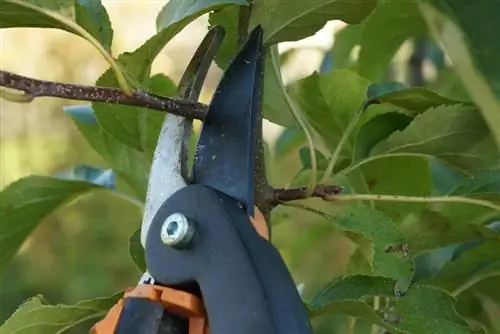
If bushes and shrubs bloom a little later in the season, they should be cut in the cold season. Although cutting is usually possible in autumn, early spring is better - before the first shoots. Again, all dead, dried up, weak or dead and frozen sections are removed. However, special attention should be paid not only to shortening all around, but also to removing disturbing shoots as close to the ground as possible. Otherwise the plant will quickly become old and will then show fewer shoots.
Due to the numerous individual characteristics and exceptions to the rules, it is only possible to a limited extent to make general statements and give instructions. Before cutting shrubs and bushes, you should find out the specific requirements of the plant.
What you should know in brief
If you want to cut bushes and trees, you not only have to know how to cut, but also when. The ideal time to prune is often important for the bush to survive and thrive. Bushes are mainly cut so that they do not become bald and age prematurely. In addition, the growth in the garden often has to be contained so that bushes do not become too large.
Cutting bushes
- In general, one can say that woody plants, which include bushes, are cut in winter, usually shortly before budding.
- Many bushes can be shaped well during the leafless period because the view is not obstructed by leaves.
- The plants are in the dormant phase. There is only a little juice in the shoots. This means that only a little juice comes out when you cut.
- In addition, significantly fewer diseases and pests occur.
Exceptions to winter pruning
- In winter, all the bushes that have already put on their flower buds last year are not cut.
- These include the typical early-flowering shrubs such as forsythia, lilac, rhododendrons, daphne and others.
- These are cut immediately after flowering and then form new buds again.
Cutting bushes
- Most shrubs are planted in spring or autumn, so this pruning must be done at this time.
- When pruning, you only adjust the ratio of roots and bushes.
- Both are shortened a little to strengthen them.
- Thin points can be removed, the strong ones remain.
- Thin roots are easily cut back, strong ones remain untouched.
Cutting types
care cut
- Thinning takes place in winter. It's easiest on bushes without leaves. You can clearly see the shape.
- The bushes must not have too many branches on the inside so that the leaves can dry well when it is wet.
- Otherwise fungi and other harmful pathogens can accumulate.
Topiary
- The topiary is also done in winter.
- This is best possible without leaves, but evergreen bushes can also be easily cut into shape.
- It's easy with stencils.
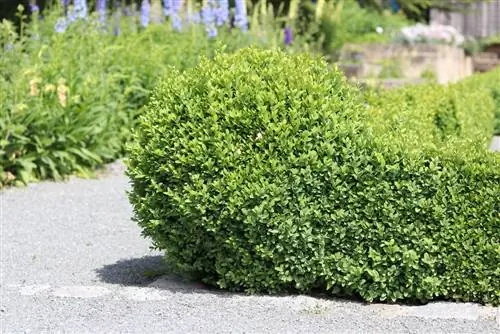
Rejuvenation cut
- This is also carried out in winter, shortly before budding.
- If the bush becomes bare from below, it is high time for a cut.
- Some bushes can be cut radically, they cope well and sprout again.
- For others you have to be more careful and spread the cut over several years.
- You only remove one or two of the bare shoots at a time until the entire bush is rejuvenated.
Conservation cut
- Maintenance pruning should be carried out when there is little sap.
- As a rule, this cut is limited to thinning. In addition, old, protruding branches are cut out.
- You should do this cut regularly, every year, then you never have to cut radilak.
Conclusion
Almost all bushes grow better when they are pruned. Pruning is usually done in winter, shortly before budding begins. Exceptions are the plants described above. It is beneficial to cut very little each year. Many trees do not tolerate radical pruning very well.

